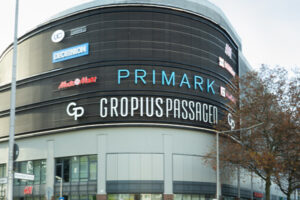By Joost Groeneveld
The three strategies include: 1) organizing multi-disciplinary teams around the shopping center manager as the “owner” of the property; 2) implementing technology applications; and 3) adopting a standard framework to position the shopping center in the market.
Uncertain Macroeconomic Environment
After a robust upswing of economic activity, when the pandemic subsided in Europe and around the globe, the macroeconomic environment became cloudy following the invasion of Ukraine. Stubbornly high inflation, as a result of global supply-chain bottlenecks has been accelerated by higher energy and food prices. According to the latest estimates by Oxford Economics, inflation in the eurozone will be 5.3% at the end of 2022.
As a result, the EU’s Economic Sentiment Index for March 2022 dropped markedly. The result was driven by lower household confidence levels concerning future financial circumstances as well as the general economic prospects. Further complicating the macroeconomic situation is the need for central banks to raise interest rates more quickly to curb inflation. Higher interest rates generally have an adverse impact on retail spending.
Despite such headwinds, the economic foundation remains relatively strong, as evidenced by low unemployment rates, growing income, and elevated wealth and personal savings levels. The latest eurozone gross domestic product forecast for 2022 was revised down to 2.9%, and private consumption remains high at 4.4%, supported by delayed spending of goods and services. These relative positive figures, combined with the historical evidence that economic activity rebounds quickly after a major shock subsides, should provide comfort to managers and investors.
Secular Trends Impacting Shopping Centers
Secular trends are significant market activities that occur over the long-term and are not cyclical or seasonal. It is important to note that secular trends impact organizations and markets differently. Three trends impacting the user experience of shopping centers can be identified: technology, shifting consumer values, interests, and behaviors, and an aging society across most European countries.
Technology enables retailers to reach a much wider customer base and to expand their sales and marketing channels using a range of digital platforms. Furthermore, technology has resulted in consumers, especially younger generations, expecting more personalized service when interacting with their favorite brands and organizations. That trend should further accelerate as new digital concepts are rolled out, corporate entities continue to invest in their technology capabilities, and start-up companies disrupt established industries.
Second, customers increasingly want to align their values and interests with likeminded people and companies. For example, a recent consumer survey conducted by GlobalData reported that 78% of respondents stated that ethical and environmentally friendly product features always, often, or sometimes influenced their product choices. That percentage increased to over 80% for millennials and the iGen generations. Alignment of values and interests also translates to people revisiting their work-life balance, as workers are returning to the office and are requesting flexible and hybrid arrangements from their employers.
Third, aging populations across Western European markets are starting to have profound impacts on communities, spending patterns, and property markets. More importantly, the baby boom generation is set to transfer its wealth to younger generations, and some estimates value this global wealth transfer at a staggering $65 trillion over the next 25 years.
Enhancing the User Experience
In these uncertain macroeconomic times, combined with secular trends that impact the performance of shopping centers, focusing on users allows for their feedback and changing behaviors to be incorporated in future decision making as well as for the delivery of consistent, high-quality service.
The starting point is to gain insight into users behavior and preferences. Periodic satisfaction surveys, exit interviews of our customers, as well as surveys of wider consumer groups that do not visit the center, and social media sites are starting points to that end. Visitors and tenants as well as service providers and community leaders should be included in the scope, and their experiences should be mapped. From such an exercise, multiple personas (an agile term used to identify the detailed characteristics of a prototypical end-user) can be distilled, thereby providing a more intuitive way to discuss the various user types, internally. Three strategies can be deployed to enhance the user experience.
How teams are organized provides an important foundation for service users, given the multi-disciplinary nature of property management. Key functions include leasing, capital markets, operations, technical support, finance and reporting, compliance, HR, technology and IT, and marketing. Because center managers interact with all users on a daily basis, they should have complete “ownership” of the property, calling on specialized teams when required. That type of structure enables the shopping center manager to be fully aligned with and committed to the objectives of the center’s actual owner(s) to drive long-term, sustainable value.
Technology enables on-site shopping center managers to be directly linked to visitors, tenants, and other stakeholders in order to streamline interactions between users and more effectively and efficiently complete daily operational tasks. A bespoke technology platform further allows teams to optimally support the center manager, and insights gathered can be used to optimally position the center in the market, which is the third strategy to enhance the user experience.
The positioning of a property relates to enhancing the attractiveness and functionality of the property within the context of the catchment area and competitive retail landscape. By adopting a standard framework, the positioning, strengths and weaknesses, and future value drivers of the property can be determined. The framework allows all specialized teams involved with the property to provide relevant input for a bottom-up analysis of the key performance metrics in a consistent and holistic manner. Defining the clear positioning of a shopping center allows for the alignment of the property’s design, look and feel, tenant-mix, capital expenditure programs, and marketing programs with the overarching future objectives of the property.
Mixed-use Scheme Aligned with User Needs
For example, Multi Corporation led the redevelopment of a project in the heart of the central shopping district in the Dutch harbor city of Rotterdam. The unique location, existing characteristics of the buildings, and specific requirements of the owners and tenants provided an opportunity to develop a mixed-use scheme aligned with the needs of the users. The project scope included a transformation of an office building into over 100 rental apartments, the upgrading of retail shops for tenants to their specifications, the introduction of new shops for Primark and a bookstore, and the renovation of a historic, listed building for ABN AMRO, a Dutch bank, into a customer branch and office space. The total GLA of the commercial space was 64,000 square meters and total investments amounted to EUR 195 million. The new residential tower, which is located in a highly desirable area of Rotterdam, combined with retail and office usages has resulted in a lively ambience during the day as well as in the evening – a priority for the local municipality. Lastly, a new integrated dispatch area in the basement ensures effective building operations and compliance with all zoning requirements.
Conclusion
Adapting to changing consumer behaviors within a challenging macroeconomic environment requires a holistic, multi-disciplinary, and agile approach. Focusing on the user experience allows managers to meet the objectives of the users and monitor how secular trends impact their centers. That approach ensures that appropriate measures are taken to drive value for all stakeholders of the shopping center.
About the author:
Joost Groeneveld is Head of Research at Multi Corporation






